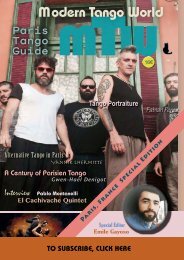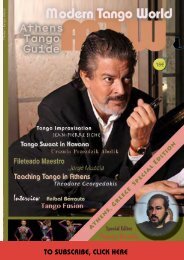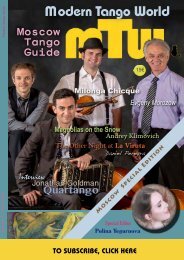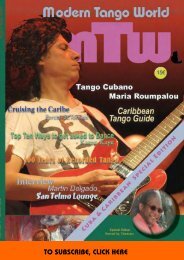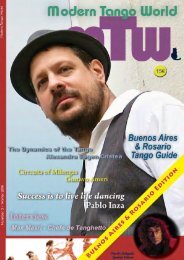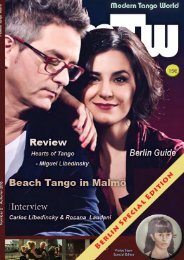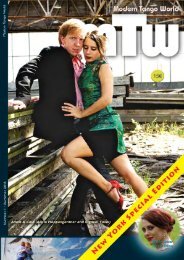Modern Tango World #9 (Rome, Italy)
Rome Special Features Symbolic Roman Tango Places Mario Abbati 03 Milongas in Rome Enrico Colagrossi 08 Roman Tango, 1980 to Present Emanuela (Mela) Molinari 13 Roman Road to NeoTango Elio Astor 16 Guide to Tango in Rome 20 Endless Tango William Hudson Temples 26 Interview with Mariano Mattone (Tangothic) Raymond Lauzzana 30 Visual dancing Andreas Lange 33 From León to Patagonia and Back Eduardo Delgado Hernández 36 New Tango Music Arndt Büssing 40 Tango Moves: Ochos (Figure Eights) Raymond Lauzzana 44
Rome Special Features
Symbolic Roman Tango Places Mario Abbati 03
Milongas in Rome Enrico Colagrossi 08
Roman Tango, 1980 to Present Emanuela (Mela) Molinari 13
Roman Road to NeoTango Elio Astor 16
Guide to Tango in Rome 20
Endless Tango William Hudson Temples 26
Interview with Mariano Mattone (Tangothic) Raymond Lauzzana 30
Visual dancing Andreas Lange 33
From León to Patagonia and Back Eduardo Delgado Hernández 36
New Tango Music Arndt Büssing 40
Tango Moves: Ochos (Figure Eights) Raymond Lauzzana 44
You also want an ePaper? Increase the reach of your titles
YUMPU automatically turns print PDFs into web optimized ePapers that Google loves.
This resulted in a standardization of tango de piste in a<br />
model to be imitated by all dancers. Since they all adopted<br />
the same style, the artistic and creative part of<br />
this wonderful dance, in which everyone can search for<br />
his own tango, was lost,<br />
It was time to take another road.<br />
But how? The dance I love cannot be relegated to those<br />
distant thirty years which will never come back again. It<br />
was hard for me to adapt to this retro trend. Although<br />
I accepted it sympathetically, was it right to take away<br />
that spirited and current modern music from the evening,<br />
even though it was enthusiastically danced by many<br />
dancers? Up to the the 1970s, as Alberto Podestà witnessed,<br />
rock & roll and tropical music was played and<br />
danced happily in every milonga of Buenos Aires. What<br />
was the point of this obfuscation?<br />
In March 2009, for the first time in <strong>Rome</strong>. I organized a<br />
milonga in which the traditional tango was not even considered.<br />
Musically, the milonga ranged from the rhythms<br />
of electronic tango to musical contaminations. The evening<br />
had 180 participants at a bar in San Giovanni. There<br />
were some who loved it and some who hated it. It made<br />
me realize that this was really something new and beautiful.<br />
Musically managing an evening of dancing with the<br />
traditional embrace to today’s music, was clearly something<br />
that violated the dance protocols. It was something<br />
that was uncomfortable with many, especially those who<br />
loved cultural tradition, folklore and retro aspect of Argentine<br />
tango. For them, the poetry of a vitrola que llora<br />
is the reason for their own life and often of their work.<br />
But many people became accustomed to dancing the<br />
the music of those thirty years. In the very beginning,<br />
the today’s music seems strange to them, unknown or<br />
undanceable. This counter-reaction will lead to to the dissolution<br />
of tango and impoverishment of tango musicians<br />
or potential tango musicians.<br />
The greatest successes of modern tango orchestras, including<br />
electronic tango, are those that play new versions<br />
of classic songs. This is because the melodies are, in some<br />
way, known and familiar. There is also the familiar rhythms,<br />
the compas, the structure and the typical musical phrasing<br />
of tango that also allow a beginner dancer to dance to<br />
an unknown piece, the arrastre which helps to step right.<br />
In some cases, we know the song so well, having listened<br />
to it and assimilated it, that we can interpret it, in dance.<br />
Some of this depends on personal tastes and adaptability.<br />
This is the case, for example, of many compositions by Osvaldo<br />
Pugliese, Horacio Salgán and Astor PIazzolla. The<br />
great composition by Eduardo Rovira, A Evaristo Carriego,<br />
famously interpreted by Osvaldo Pugliese, is difficult to<br />
interpret in the biomechanics of tango without knowing<br />
it before, just as Astor Piazzolla’s Oblivion, Johann Sebastian<br />
Bach’s allegro of the Fourth Brandenburg Concerto and<br />
Nothing else Matters by Apocalyptica. A modern tango<br />
has to become an old friend to be interpreted into tango<br />
dance by average dancers.<br />
I’ve spent more than 5000 hours behind the console,<br />
both at traditional and alternative milongas, playing music<br />
in many milongas and also in Buenos Aires as well as at<br />
international festivals. There is one episode that truly impressed<br />
me. It has, in some ways, become very illuminating<br />
to my path.<br />
In December 2009, I also<br />
founded the <strong>Tango</strong>eventi Association,<br />
which I continued along<br />
with Fatima Scialdone until<br />
2016. I curated the musical programming<br />
providing for a strong<br />
openness to modern and social.<br />
Felix Picherna, who was one of<br />
the last DJs to witnessed the<br />
golden age of the tango, argued<br />
rightly that the golden era<br />
of tango will never come back<br />
again. No one will ever write<br />
tangos with the same words,<br />
with the same intensity, with the<br />
same poetry and the same feeling<br />
in the musical performance<br />
as they did back then.<br />
— 19 —<br />
TO SUBSCRIBE, CLICK HERE




